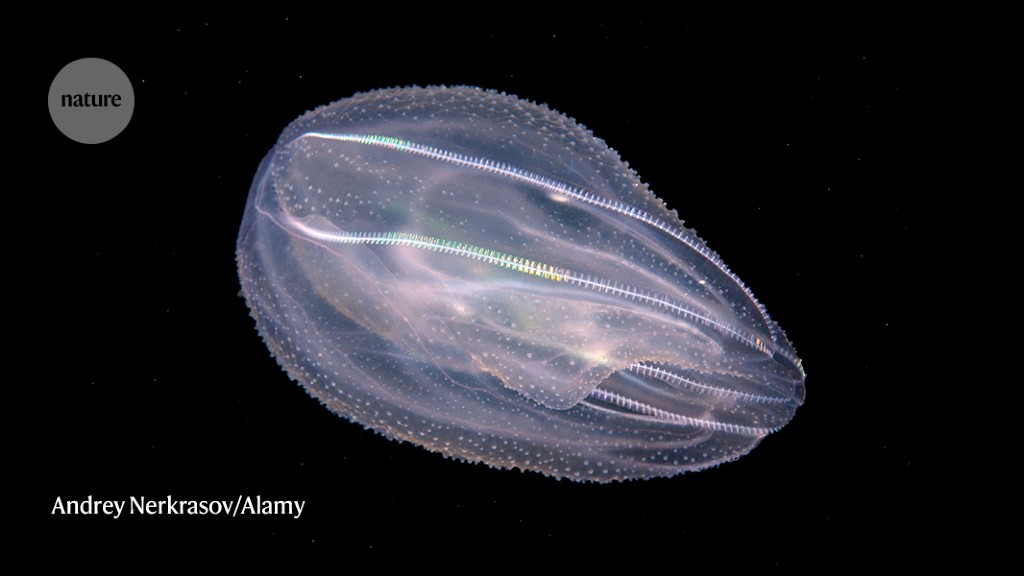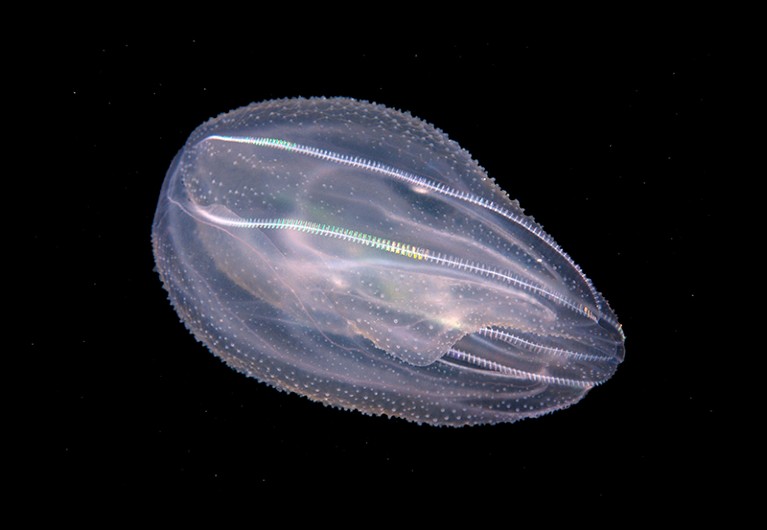Ctenophores, also known as comb jellies, have a fused network of neurons.Credit: Andrey Nerkrasov/Alamy
In a comb jelly’s nervous system, certain neurons are fused directly to each other, rather than connecting through synapses — a finding that challenges theories about how the nervous system evolved.
Ctenophores, also known as comb jellies, are gelatinous marine animals that use tiny hairs to move through water. They are one of the earliest known multicellular organisms and are useful for investigating the origin and evolution of nervous systems.
Maike Kittelmann, a biologist at Oxford Brookes University, UK, and her colleagues studied the nervous system of a ctenophore in the larval stage. The team created a 3D reconstruction of the ctenophore nerve net, a diffuse network of neurons that is a part of the animal’s nervous system. They used an electron microscope that takes several images as a diamond knife shaves off the top section of the sample after each scan. The stacked images were then reassembled to form a high-resolution 3D data set.
The team found an unusual trait: the neurons in the comb jelly’s nerve net are not connected by synaptic junctions, as would be expected in the nervous system of any other animal. Instead, they are fused and share a continuous membrane, forming what scientists call a syncytium.
“When we think about neurons and how they connect to make nervous systems, we always assume that neurons are separate cells, and they communicate through synaptic junctions or synapses,” says Kittelmann.
The fused neurons that make up the continuous membrane are specific to the nerve net. They are not found in other parts of the ctenophore nervous system, which includes sensory cells and tentacle nerves. The results, published in Science on 20 April1, surprised Kittelmann and her team members, who wanted to be certain about what they had discovered. “It’s quite a bold statement, so you don’t want to publish something that you’re not 100% sure about,” says Kittelmann. They used laborious but very-high-resolution transmission electron microscopy to double-check that no synapses were present. “That was important to make us confident that what we were seeing was not an artifact.”
An independent origin
Ctenophores’ distinct nerve net supports the idea that their nervous system could have evolved independently of that of other animals. “For a long time, it was assumed that the nervous system arose once and was never lost,” says evolutionary biologist Casey Dunn at Yale University in New Haven, Connecticut. “We’ve learned that the picture is a lot more nuanced,” Dunn says.
Previously, sponges were considered the sister group of all other animals, having diverged from the tree of life before the origin of neurons. But Kittelmann’s latest result, alongside other findings, suggests that ctenophores might instead be the sister group, having developed a nervous system independently.
Neuroscientist Leonid Moroz, at the Whitney Laboratory for Marine Bioscience at the University of Florida in Saint Augustine, investigated this hypothesis in 20142. His team analysed the genome of a species of comb jelly and found that the sequence omitted important genes, including those involved in neural function, that are found in other animals. This prompted Moroz and his colleagues to hypothesize that ctenophores evolved a nervous system independently. At the time, these results were met with scepticism. “Most people said it was a crazy idea,” Moroz says. “It was against common wisdom.” He thinks that the data from the latest study support the hypothesis that the ctenophore nervous system evolved independently. “I consider this paper a very good catalyst for future exploration.”
The team did “terrific work” with the 3D reconstruction of the animal’s nerve net, adds Moroz, but notes that it depicted only 5 nerve-net neurons out of thousands. “I think it’s the beginning of a long road.”
The results also rekindle a century-old debate involving the two neuroscientists who shared the 1906 Nobel Prize in Physiology or Medicine for their work on the structure of the nervous system. Whereas biologist Camillo Golgi proposed that animal nerve cells formed a continuous, conjoined network, neuroscientist Santiago Ramón y Cajal contended that neurons were distinct cells connected through synapses. Cajal’s theory was later confirmed by electron microscopy, putting the debate to rest. But the latest finding suggests that Golgi’s theory could also have value.
Kittelmann says that the next step will be to look into other species of ctenophore and to study them in different stages of development.
Dunn says that comb jellies are often dismissed as quirky animals. “Very little is known about the ctenophore nervous system, which is really surprising given their importance to the understanding of the evolution of the nervous system,” he says. “The authors are filling in some very important holes.”








More News
Old electric-vehicle batteries can find new purpose — on the grid
Finding millennia-old ‘monumental’ corals could unlock secrets of climate resilience
Argentina’s pioneering nuclear research threatened by huge budget cuts